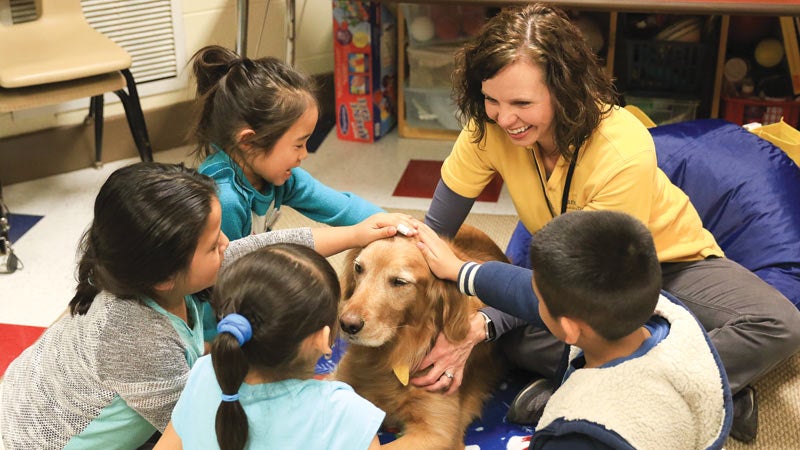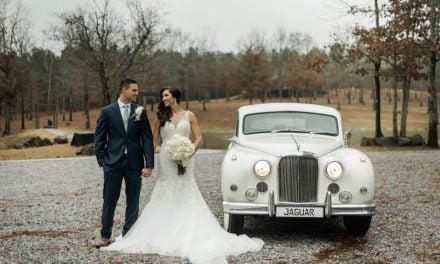Through positive interactions, therapy dogs help students with literacy, behavior and other issues
Written by Emily Sparacino
Photographs by Dawn Harrison
Wallace the Golden Retriever knows when he is about to go to Inverness Elementary School for his weekly visits with English as a Second Language students every Thursday.
With his yellow bandana on and his tail wagging, Wallace gets in the car and stays there until Dr. Laura Falone, his owner and Therapy Team partner in the Hand in Paw nonprofit organization, is ready to go.
“This is literally what he lives for,” Falone said, as she and Wallace walked through the hallways at IES toward ESL teacher Kiffany Rueda’s classroom one Thursday afternoon in February, stopping occasionally to allow students and teachers to pet their favorite four-legged visitor. “He absolutely loves coming.”
Falone and Wallace have been active with Hand in Paw since June 2016, and they started coming to IES for the organization’s Sit, Stay, Read! program in October.
Like other therapy dogs in the area, Wallace has become a celebrity, of sorts, in the community.
It’s hard to determine whether he or the students are more excited for “Wallace Day,” the new name for Thursday at IES.
The same is true about Warrior, Alabaster City Schools’ therapy dog, when he visits students.
Like Wallace, Warrior seems to thrive in the company of students as much as they seem to benefit from his presence.
As therapy dogs, Warrior and Wallace are among a select group of animals helping students with literacy, behavioral problems, emotional trauma and other issues––all while simultaneously serving as “goodwill ambassadors” around the county.
WARRIOR: ‘HE HAS BEEN AMAZING’
Warrior has served as the ACS therapy dog since 2013.
Wendy McNish, at-risk counselor for ACS and Warrior’s owner, wanted to bring in a therapy dog to work with students at the alternative school.
She pitched the idea to others in the school system and received positive responses.
A breeder donated a 6-week-old half-Australian Shepherd, half-American Eskimo puppy to McNish for the position.
McNish picked up Warrior from the breeder on a Sunday, and the next day, the city’s Board of Education voted him in as the school system’s official therapy dog.
His training started immediately.
Warrior has attended private training sessions with Birmingham’s Rebecca Mason since he was a puppy, and he recently completed tricks training classes with her, McNish said.
“With his personality, his forte is the tricks,” she said. “The children are so impressed by that. He’s doing very well in everything he’s done.”
Warrior jumps through hula hoops, plays the piano and is learning how to ride a skateboard.
“We go into classes and talk about exercise and nutrition, we talk about food and we talk about paying attention and following directions,” McNish said of her and Warrior, and added, “He performs tricks for them. He is the No. 1 requested prize for attendance and discipline.”
Although McNish’s original idea was for Warrior to work mostly with at-risk and alternative school students, his popularity took off faster than she could have imagined.
In addition to visiting with groups of students, Warrior also works with students one-on-one in individual counseling sessions. He has worked with non-verbal students, students with mental health issues, students who are homebound due to injury or illness and students in the hospital.
“They just love a visit from him,” McNish said. “He does a really good job.”
McNish receives special requests for Warrior constantly.
Warrior makes appearances at community events, including Alabaster’s Christmas parade, Special Olympics, Angel Warriors, pep rallies, football games and many others.
He has presented at large-scale events, including the Alabama State Department of Education’s MEGA Conference in Mobile and a school principals’ conference at the Wynfrey Hotel in Birmingham.
“We do about everything,” McNish said.
Warrior’s temperament makes him a great fit as a therapy dog.
He’s friendly, intelligent, task-oriented, energetic, not aggressive and unfazed by loud noises.
“He’s very loving, loves to be petted, very energetic … his energy level is out the roof,” McNish said. “When he hears applause, he gets excited because he thinks it’s about him.”
And, chances are, it is about him.
Warrior’s effect on students reaches beyond entertainment.
McNish said he has a “calming effect” on students, even if they’ve come from volatile situations at home.
And students unable to open up to, or empathize with, other people connect with Warrior.
He has worked with students with language deficits and special needs.
“He helps break the ice and tension,” McNish said. “When he walks in, it calms them.”
His absence from the schools on his “off” days doesn’t go unnoticed among students.
“If he’s not here, they want to know where he is,” McNish said. “He’s a busy little dog.”
On his days off, Warrior can be found on McNish’s farm with the family’s goats, chickens and a Great Pyrenees.
“When he’s not here, he stays home in a big pasture with the animals,” McNish said. “I work with him for hours at home. We have to take him to the dog park a couple times a month to get him around other dogs. We try to keep him exposed to everything. He pretty much adapts to any situation he’s in.”
While at the park one day, a young girl approached McNish and said, “Is that the real Warrior? This is a dream come true!”
McNish said the girl told her she was going to tell all her friends at school the next day that she got to meet Warrior and pet him.
“He is our goodwill ambassador,” McNish said of her black and white sidekick. “That’s exactly what he does.”
He will turn 4 years old Sept. 1.
McNish strives to keep Warrior available to fill as many requests as possible, even if it means working nights and weekends sometimes.
When Warrior brightens the day of a student battling an illness, his impact comes into focus.
“It’s a community effort,” she said. “We hope it sends the message to kids that what they’re going through is important to Alabaster City Schools and the city, because kids have a lot to go through.”
McNish said she is grateful to Alabaster City Schools for being “willing to think outside the box in education” and embracing innovative methods of working with students.
“It’s just been amazing the opportunities we’ve had,” McNish said of her and Warrior. “He fits in very well. He has been amazing.”
WALLACE: ‘HE IS LITERALLY MADE FOR THIS’
Falone adopted Wallace when he was 10 months old from Adopt A Golden, a volunteer organization whose mission is to find permanent homes for Golden Retrievers.
Falone is a part-time veterinarian at Valleydale Animal Clinic. As a vet school student at Auburn University, she was involved with a program similar to Hand in Paw.
She knew she needed the right dog in order to become a Therapy Team for Hand in Paw.
Then, she found Wallace. And after socialization and obedience training, she and Wallace started the testing process with Hand in Paw in January 2016.
He passed the last test in May, and five months later, was making more friends than he could count at IES.
In the Sit, Stay, Read! program at IES, nearly 30 kindergarteners and first graders split into groups of four to five students cycle through Rueda’s classroom to spend time with Wallace; to pet him and talk to him while also honing their reading, writing and speaking skills.
“He is literally made for this,” Falone said. “He’s not even nervous. He loves it. We come every week, and we have lots of fun.”
As Falone talks to the students about their weeks, Rueda prompts them to verbalize what they have learned about Wallace – what he eats and drinks, what characteristics define his breed and what veterinarians like Falone do to keep Wallace and other animals healthy.
“All year, we’ve been researching about Wallace,” Rueda said, noting the students have been working on “All About Wallace” books, which they periodically read aloud to Wallace.
One day, Falone brought her stethoscope and let the students take turns listening to Wallace’s heartbeat with it. They also practiced wrapping his leg in a bandage.
“It’s our project-based learning,” Rueda said. “They’re so involved in it, and they’re really excited.”
Falone said Wallace also has the opportunity to impact students that aren’t in the ESL program. Each time Wallace walks through the hallways, children he passes can have a positive interaction with a dog.
Prior to starting the program at IES, Wallace visited nursing homes last summer, Falone said.
If the effectiveness of Wallace’s visits is uncertain, one need only to watch a group of students rush to him on the carpet and start talking not only about him, but to him, as a friend.
“This is his favorite thing to do all week long, to come see you guys,” Falone said to a group of students, just before they petted him one last time and said goodbye until his next visit.
THERAPY DOGS: ‘IT’S DEFINITELY A MOTIVATOR’
As program coordinator for Hand in Paw, Emily Cheatwood helps prepare local teachers for the implementation of animal-assisted therapy in their classrooms.
Sit, Stay, Read! is one of the programs in which Hand in Paw’s Therapy Teams, including Falone and Wallace, are involved on the local level.
According to Hand in Paw’s website, “Sit, Stay, Read! helps reluctant young readers improve skills by reading aloud to calming, motivating therapy animals. Hand in Paw’s specially-trained Therapy Teams make reading a non-threatening and positive learning experience. Because pets accept people without conditions, the human-animal bond creates a relationship free of the stress of judgments and expectations.”
“Many (children) are afraid of dogs,” Hand in Paw Associate Director Liz Wilson said, adding the program is designed to help them overcome that fear in the process of improving literacy skills. “They get excited. It’s definitely a motivator. It calms and motivates.”
Cheatwood said Vincent Elementary School uses one of the Therapy Teams as a motivator for truancy, and in the first two weeks, they had 100 percent attendance.
“They kind of belong to the school,” Wilson said of the therapy dogs. “It brings comfort.”
Hand in Paw serves Shelby, Jefferson and Tuscaloosa counties in about 100 sites throughout the three counties, with about 120 Therapy Teams and 40-50 visit assistants.
Along with Sit, Stay, Read!, therapy animals visit early intervention programs for infants and toddlers, nursing homes, hospitals, palliative care facilities, domestic violence shelters, non-profit agencies and Department of Human Resources group homes.
“We do a lot of community education on top of the goal-oriented education,” Wilson said. “We hear sometimes a dog will motivate a patient when no one else will.”
Hand in Paw offers multiple volunteer opportunities. People can be handlers with their animals on Therapy Teams; serve as visit assistants and ambassadors; or support Hand in Paw as a general volunteer.
The program is not limited to dogs, either. Cats, rabbits, guinea pigs, goats and a rat have been therapy animals, and others, such as pigs, mini horses, llamas and birds, could qualify.
To learn more about Hand in Paw and the volunteer requirements, training steps and application process, visit Handinpaw.org.










